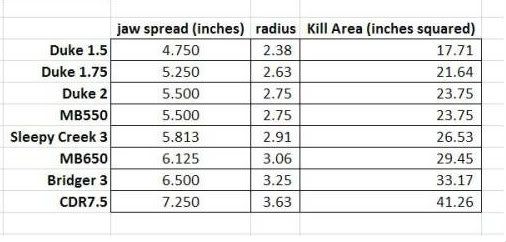|
|
Post by seldom on Sept 16, 2012 11:54:18 GMT -6
I have a question and since this thread has had 2400 hits, there should be some answers!
I don't own any TS85's but I do have some 1/4" laminated MB750's and some 1/4" laminated #3 Bridgers. During this thread folks talked about the relationship of too high catches due to the increased jaw spread. I measured an MB across the jaw corners closed(end to end so to speak) and it measured 7.5" and I measured the closed trap height which was 5". I than measured a #3 across the jaw corners and it measured 4.33" and the height measured 4.25".
The question is- Comparing the two sets of dimensions(7.5"x5"///4.33"x4.25"), would there ever be a set or type of set that comes to mind where the 7.5" would be an advantage over the 4.33"?
|
|
|
|
Post by trapperpatt on Sept 16, 2012 17:52:51 GMT -6
Now this is just me thinking, but what if he still uses the cdr and guides too. Wouldn't that increase his chance of catching his target animal. As long as he uses the modified pans.
|
|
|
|
Post by seldom on Sept 16, 2012 19:05:02 GMT -6
The question is- Comparing the two sets of dimensions(7.5"x5"///4.33"x4.25"), would there ever be a set or type of set that comes to mind where the 7.5" would be an advantage over the 4.33"?  Seldom, Personally,,,I would use these numbers as my starting point. Your #3bridger 1/4in Lams make it 7in... Think Aspect of the set !!  It's the aspect of the type of set is why I referenced the jaw corner measurement rather than the "kill area". Maybe I should have used the term "the use" of the trap rather than the "set" or "type of set". |
|
|
|
Post by redeagle on Sept 16, 2012 21:47:08 GMT -6
Clint more or less summed up his philosophy in his tape by saying, in a nutshell, he's not out to play games with the animals. He's out to win. He does not want to give the animal a fair chance to avoid getting caught. He wants to stack the deck in his favor for making a catch.
|
|
|
|
Post by trappincoyotes39 on Sept 17, 2012 16:08:49 GMT -6
redeagle no offense but isn't that what everyone tries to do? Stack the odds in one's favor be it trapping, hunting or fishing? Becuase I use a somewhat smaller trap his opinion is I'm giving them more of a fair chance?  Could it be other's setting techniques and set procedures could be getting the same results without having to use a beaver trap to catch a high % of coyotes? Is that even a plausable thought? |
|
|
|
Post by trappnman on Sept 17, 2012 18:22:31 GMT -6
Could it be other's setting techniques and set procedures could be getting the same results without having to use a beaver trap to catch a high % of coyotes? Is that even a plausable thought?
p/]
you bet- its why some have success with 1.75s
|
|
|
|
Post by trappincoyotes39 on Sept 17, 2012 18:53:27 GMT -6
sure some do but one can have more success with a bigger trap correct??? It isn't about what you hold but what you miss correct?
I guess what do you want me to say? That I'm wrong and the bigger the better because it has to be??? Not the case at all. I mean we have all went through trying to trap coyotes with traps that are too small for maximum efficantcy, yet I believe there is also too big as well. When one considers all the aspects of setting to the catch. IMOC.
|
|
|
|
Post by trappnman on Sept 18, 2012 8:13:11 GMT -6
TC- all I want you do say, as you've asked LOL, is that surely under some circumstances- deep snow in the dead of winter perhaps- a bigger trap that perhaps is impractical for day to day use (which is the point I object to in that video) might be the difference between failure and success.
and that under these circumstances, a bigger trap would be better.
whats too big is of course debatable- whose to say a #5 montana is too big, just right or too small>
|
|
|
|
Post by trappincoyotes39 on Sept 18, 2012 15:59:56 GMT -6
All depends on your expected outcome I guess? Do I want a trap that large to be one solid ice ball on the end of a coyotes foot? Or bobcat for that matter on a 3 day check? Heck no not even on a 24 hr check.
I have trapped a few and then a few more in really cold and snowy conditions and again the way you set has alot to do with the outcome. The trap itself is a pieace of the puzzle, the setting techniques, sets used, guiding, bait and lure placement all add into the part on efficantcy.
Again in deep snow it might have a slight advantage but last I knew locklear isn't deep snow trapping in texas. He is calling this a day to day trap choice and one he recommends to anyone tuning in to youtube.
It's all debatable for sure, but I debate you don't need a trap that large to trap coyotes and "win".
I'll end this like this, if you feel the need to dirt trap with these traps do so and tell us in 1 year how much better they are than more standardized coyote traps. Show some picks of catches, what the feet look like and what noticeable differance you see in using such a trap. I will tell new coyote trappers not to go that route and the reason as to why not.
|
|
|
|
Post by seldom on Sept 18, 2012 16:31:30 GMT -6
All depends on your expected outcome I guess? Do I want a trap that large to be one solid ice ball on the end of a coyotes foot? Or bobcat for that matter on a 3 day check? Heck no not even on a 24 hr check. I have trapped a few and then a few more in really cold and snowy conditions and again the way you set has alot to do with the outcome. The trap itself is a pieace of the puzzle, the setting techniques, sets used, guiding, bait and lure placement all add into the part on efficantcy.. Finally TC, after all these pages of posts, I've been waiting for you or others to step out of the "conventional" box of canine trapping and consider options and alternatives where a larger jaw spread would be advantageous. It took Steve's persistence to get it done but come easy, come hard, they all come!!! Thank you!  Since we lost our snares in 2005 I've been trapping in deep snow with #3 Bridger and similar size traps and I can say that I've never had a trap "ice, ball-up" on our 24hr checks. As I tried to point out earlier in this thread to get the "in-the-box" folks to think outside the box, if you trap in deeper snow (nothing less than 6"-8") and can't use snares, think about your options and if they include a larger jaw spread for efficiency sake? The answer, in general form, is found in your 2nd paragraph! Thank you!  I'm happy now so I'm done with the thread.  ;D |
|